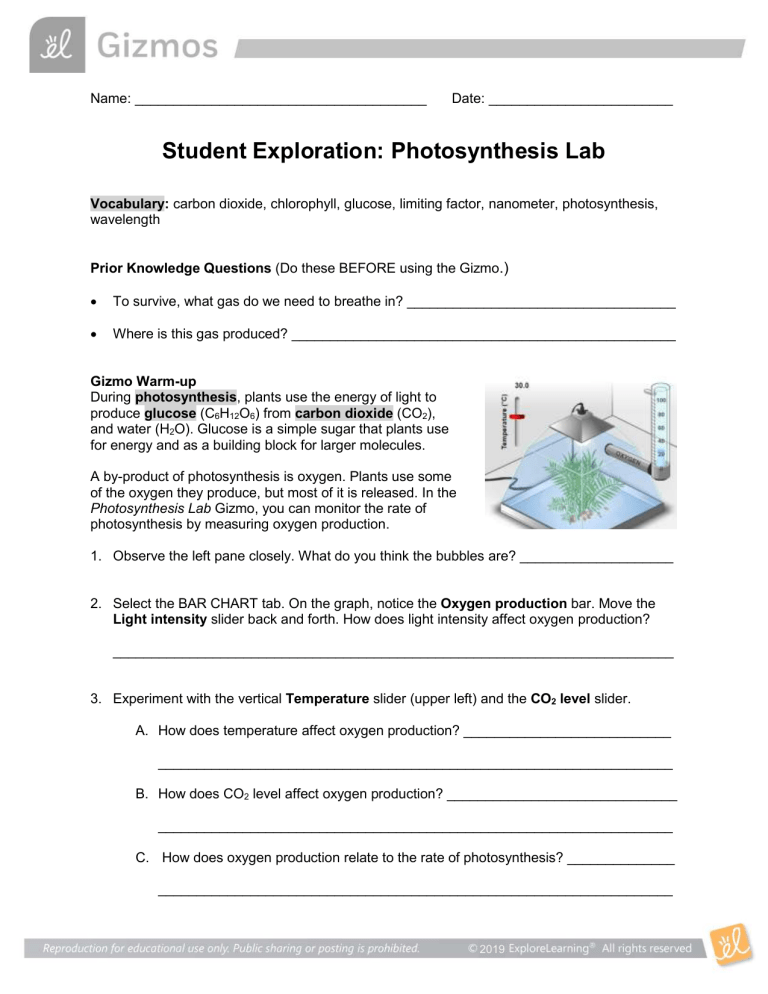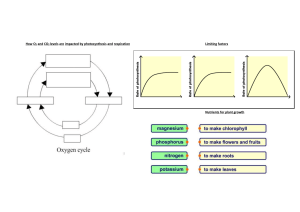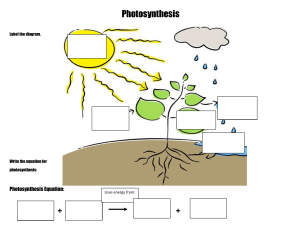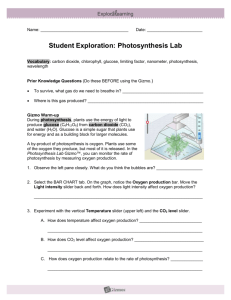
Name: ______________________________________ Date: ________________________ Student Exploration: Photosynthesis Lab Vocabulary: carbon dioxide, chlorophyll, glucose, limiting factor, nanometer, photosynthesis, wavelength Prior Knowledge Questions (Do these BEFORE using the Gizmo.) To survive, what gas do we need to breathe in? ___________________________________ Where is this gas produced? __________________________________________________ Gizmo Warm-up During photosynthesis, plants use the energy of light to produce glucose (C6H12O6) from carbon dioxide (CO2), and water (H2O). Glucose is a simple sugar that plants use for energy and as a building block for larger molecules. A by-product of photosynthesis is oxygen. Plants use some of the oxygen they produce, but most of it is released. In the Photosynthesis Lab Gizmo, you can monitor the rate of photosynthesis by measuring oxygen production. 1. Observe the left pane closely. What do you think the bubbles are? ____________________ 2. Select the BAR CHART tab. On the graph, notice the Oxygen production bar. Move the Light intensity slider back and forth. How does light intensity affect oxygen production? _________________________________________________________________________ 3. Experiment with the vertical Temperature slider (upper left) and the CO2 level slider. A. How does temperature affect oxygen production? ___________________________ ___________________________________________________________________ B. How does CO2 level affect oxygen production? ______________________________ ___________________________________________________________________ C. How does oxygen production relate to the rate of photosynthesis? ______________ ___________________________________________________________________ 2019 Activity A: Ideal conditions Get the Gizmo ready: Be sure that the BAR CHART tab is selected. Turn on Show numerical values. Question: In the Gizmo, what are the ideal conditions for photosynthesis? 1. Form hypothesis: During photosynthesis, light energy is used to synthesize carbon dioxide (CO2) and water (H2O) into glucose (C6H12O6) and oxygen (O2). The complex series of chemical reactions is summarized by the following formula: 6CO2 + 6H2O + light energy C6H12O6 + 6O2 In the Gizmo, what light intensity and CO2 level do you think will maximize the rate of photosynthesis? ___________________________________________________________ 2. Experiment: Use the Gizmo to find the ideal conditions for photosynthesis. Use any method you like. When you think you have the answer, list the conditions below. Temperature Light intensity CO2 level Oxygen production 3. Revise and repeat: One way to test if you’ve found the ideal conditions is to change each variable slightly from the value that you recorded above. If the oxygen production decreases with each change that you make, it is likely you have found the ideal conditions. If a small change causes oxygen production to increase, continue to experiment. If necessary, revise your numbers in the table above. 4. Think and discuss: Think about the process of finding the ideal conditions. A. Why would it be hard to find the ideal light intensity if the temperature were very hot or cold? ____________________________________________________________ ___________________________________________________________________ B. Why would it be hard to find the ideal CO2 level if the light intensity were very low? ___________________________________________________________________ ___________________________________________________________________ 2019 Get the Gizmo ready: Activity B: Colored light Select the COLOR tab and the BAR CHART tab. Set the Temperature to 24°C, the Light intensity to 90%, and the CO2 level to 1,000 ppm. Introduction: Plants use a green pigment called chlorophyll to absorb light and convert its energy into a form that the plant can use. Chlorophyll gives plants their green color. Question: What color of light is the best for photosynthesis? 1. Observe: The color of a light wave is determined by its wavelength. On the COLOR tab, slowly drag the Light wavelength slider back and forth and observe the effect on oxygen production. How does the color of light affect the rate of photosynthesis? _________________________________________________________________________ _________________________________________________________________________ 2. Form hypothesis: Which color of light do you think will maximize the rate of photosynthesis? _________________________________________________________________________ 3. Gather data: Set the Light wavelength to 400 nm. (The symbol “nm” stands for nanometers. A nanometer is a billionth of a meter.) Visible light ranges from 400 to 700 nm. On the TABLE tab, click Record data. Then set the Light wavelength to 420 nm, and repeat. Continue recording data in the Gizmo every 20 nm until the wavelength is 700 nm. 4. Make a graph: Select the GRAPH tab and select Wavelength. Sketch the graph in the space at right. A. Which colors were absorbed best by the plant? ______________________________ B. Which colors were absorbed worst? ____________________________________ 5. Think and discuss: When we look at a leaf, we see the colors of light that are reflected off its surface. How does this explain the relatively low flow of oxygen in green light? _________________________________________________________________________ _________________________________________________________________________ 2019 Get the Gizmo ready: Extension: Limiting factors Select the WHITE tab and the BAR CHART tab. Turn on Show numerical values. Introduction: Photosynthesis requires light, water, and CO2 to work. When one of these factors is in short supply, it is called a limiting factor. Temperature can also be a limiting factor when it is too hot or too cold for photosynthesis to work well. Question: What is the effect of limiting factors on photosynthesis? 1. Observe: Set Temperature to 24°C, Light intensity to 50%, and CO2 level to 200 ppm. A. Move the Temperature slider up and down. Were you able to increase oxygen production? _____________________ (Return the slider to 24°C when finished.) B. Move the Light intensity slider back and forth. Were you able to increase oxygen production? _____________________ (Return the slider to 50% when finished.) C. Move the CO2 level slider back and forth. Were you able to increase oxygen production? _____________________ (Return the slider to 200 ppm when finished.) 2. Analyze: In this situation, what was the limiting factor? _____________________________ How do you know? _________________________________________________________ _________________________________________________________________________ 3. Challenge: In each of the situations below, use the Gizmo to find the limiting factor. Temperature Light intensity CO2 level 25°C 60% 700 ppm 15°C 20% 200 ppm 30°C 50% 400 ppm Limiting factor 4. Think and discuss: Suppose you were a farmer trying to grow plants in a greenhouse. Why would it be important to know what the limiting factor is? _________________________________________________________________________ _________________________________________________________________________ 2019






